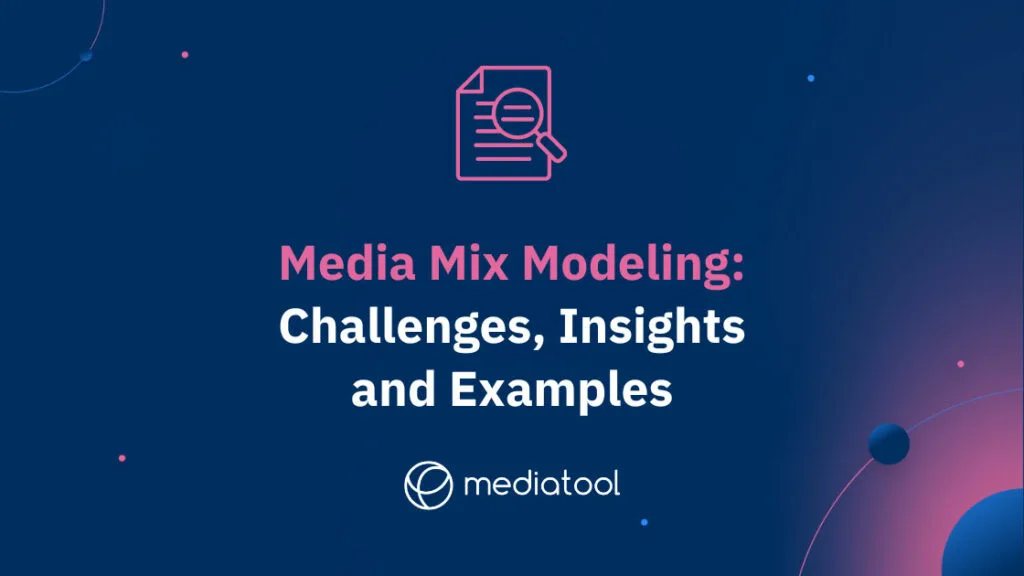In this article, we’ll explore the fundamentals of Media Mix Modeling, its key components, and the process of building and applying a robust model. We’ll also dive into practical examples across different industries and weigh the advantages and disadvantages.
Let’s get started.
What is Media Mix Modeling MMM?
Media Mix Modeling (MMM) is an advanced analytical tool that enables marketers to fine-tune their marketing strategies. By evaluating the effectiveness of various marketing channels and tactics, MMM guides businesses in making data-driven decisions. This approach involves analyzing sales data and other key performance indicators (KPIs) to assess the impact of different marketing activities.
MMM uses historical data to understand the contribution of each element in the marketing mix to overall sales volume and market share. Through statistical analysis, it quantifies the effect of various marketing efforts, including digital channels and traditional media campaigns, on incremental sales and marketing performance.
This method helps marketing teams allocate their marketing spend more effectively, ensuring that each marketing dollar contributes optimally to marketing ROI. By understanding how different marketing channels influence consumer behavior and sales outcomes, businesses can optimize their media mix, enhance marketing effectiveness, and create more accurate sales forecasts.
The use of MMM is especially beneficial for modern marketing, where understanding the interplay between multiple marketing tactics across various marketing channels is crucial. It provides granular insights into how external factors and marketing inputs impact marketing efforts, allowing for more precise marketing budget allocation and planning for future campaigns.
In today’s rapidly evolving media landscape, having a solid grasp of media mix modeling is essential for staying ahead of the competition and delivering outstanding results.
“Coming out of the variability of the pandemic years, coupled with recent economic uncertainty, we will see the comeback of forecasting through media mix modeling (MMM) as a way to determine the impact of marketing tactics on a business objective, alongside data-driven attribution.”
Marketing Mix Modeling
Essential Tool for Strategic Marketing
Marketing Mix Modeling has become an essential tool for many marketing teams. This technique helps in understanding how various marketing tactics within the media mix contribute to overall business objectives. By analyzing historical data inputs, marketing mix modeling, along with marketing mix models, assesses the effectiveness of each marketing initiative and its role in driving total sales and incremental sales.
Analyzing the Impact of Marketing Efforts
Marketing mix modeling primarily focuses on evaluating the ROI of different marketing campaigns, including advertising strategies and media spend. It uses statistical methods, such as multi-linear regression, to correlate marketing efforts with sales outcomes. This analysis, often conducted using marketing mix model methodologies, helps in understanding the contribution of each marketing channel – both independent and dependent variables – to the overall marketing effectiveness.
Data-Driven Insights for Budget Allocation
Marketing mix modeling leverages data-driven attribution models to provide insights into how best to allocate marketing budgets. By analyzing historical aggregated data, marketing mix modeling, supplemented by media mix models, helps in forecasting future sales and optimizing media mix modeling ratios. This ensures that marketing dollars are spent in areas that yield the highest return.
How Does Media Mix Modeling Work?
It can be broken down into several steps.
1. Data Collection and Preparation
The first step in media mix modeling involves gathering and organizing a range of data. This includes historical data on marketing activities, sales volume, and external factors like seasonality, competitor actions, and macroeconomic indicators. Cleaning, preprocessing, and structuring this data is crucial to ensure the accuracy and reliability of the MMM.
2. Statistical Analysis and Model Development
Next, marketers develop a statistical model to establish the relationships between marketing efforts and targeted outcomes or Key Performance Indicators (KPIs). Techniques like regression analysis, time series analysis, or machine learning algorithms are employed based on the specific marketing scenario. These models help in understanding the impact of various marketing tactics, including marketing and advertising campaigns, on KPIs such as sales, leads, or customer acquisition.
3. Simulating Marketing Scenarios
With the model in place, marketers can simulate different marketing strategies. Adjusting variables like ad spend, media mix, and campaign timing, allows for the identification of strategies that maximize marketing ROI. The model also supports sensitivity analyses, enabling marketers to gauge how changes in certain variables could influence outcomes.
4. Model Validation and Calibration
Regular validation and calibration of the model are essential. This process may involve updating with new marketing data, refining model parameters, or integrating new marketing trends to maintain relevance. Marketers must adapt the model to reflect changes in the marketing landscape, ensuring ongoing accuracy and usefulness.
Practical Applications of MMM
MMM is a powerful tool for marketing managers, helping to allocate marketing budgets efficiently and optimize media spend. It guides decisions on where to allocate marketing dollars for maximum effectiveness, considering factors like brand equity and consumer trends. Additionally, MMM can be instrumental in creating sales forecasts and planning future campaigns at a national or regional level.
By incorporating these steps and concepts, media mix modeling becomes an integral part of a comprehensive marketing strategy, providing insights that drive data-driven attribution and improve overall marketing effectiveness.
Media Mix Modeling Examples
This section will explore three practical examples of media mix modeling applications across different industries, each with unique objectives and challenges. These examples showcase how media mix modeling can be tailored to specific business contexts and provide valuable insights for optimizing marketing strategies.
Consumer Packaged Goods (CPG) Company
Objective: Optimize advertising budget allocation across channels to maximize sales.
Data: The company collects data on marketing spend, reach, and frequency for TV, radio, print, digital, and social media channels. It also gathers information on sales, competitor activities, promotions, and seasonal patterns.
Model: The media mix model uses regression analysis to quantify the impact of each marketing channel on sales. It accounts for external factors, such as seasonality and competitor actions, to ensure accurate results.
Application: Using the model, the company simulates different budget allocations and identifies the optimal mix that maximizes sales while minimizing costs. The model helps the company shift resources to high-performing channels, adjust campaign timings to capitalize on seasonal trends, and respond more effectively to competitor actions.
E-commerce Retailer
Objective: Assess the impact of various online marketing campaigns on sales and customer acquisition.
Data: The retailer collects data on paid search, display advertising, email marketing, and social media campaigns, along with information on website traffic, online sales, customer acquisition, and retention.
Model: The media mix model employs machine learning algorithms to analyze the relationships between marketing activities and online sales. The model accounts for customer demographics, browsing behavior, and device usage.
Application: The retailer uses the model to evaluate the effectiveness of each marketing campaign, identify underperforming channels, and optimize budget allocation. This enables the company to focus on high-converting tactics, improve customer targeting, and enhance overall marketing performance.
Automotive Industry
Objective: Measure the effectiveness of promotional activities and allocate resources to maximize sales.
Data: The company collects data on dealer incentives, auto shows, sponsorships, and advertising across various channels. It also gathers information on sales, market share, competitor activities, and macroeconomic indicators like consumer confidence and disposable income levels.
Model: The media mix model uses time series analysis to determine the impact of each promotional activity on sales and market share, accounting for external factors like competitor actions and macroeconomic conditions.
Application: By analyzing the model results, the automotive company can identify the most effective promotional activities and allocate resources accordingly. For example, they might increase dealer incentives in regions leading to higher sales, invest in sponsorships that resonate with their target audience, or adjust their presence in auto shows to maximize visibility and engagement. The model also helps the company anticipate market trends and adjust its marketing strategy proactively to stay ahead of the competition.
These examples demonstrate the versatility of media mix modeling across industries and objectives. By tailoring the model to specific contexts and data sources, marketers can gain valuable insights that inform their decision-making and drive better marketing outcomes.
Advantages and Disadvantages of Media Mix Modeling
Media mix modeling offers several advantages for marketers.
Key benefits include:
Improved decision-making: By quantifying the impact of various marketing channels and tactics, MMM enables data-driven decision-making and helps allocate resources more efficiently.
ROI optimization: MMM helps marketers identify the most effective marketing mix, maximizing the return on investment.
Scenario analysis: MMM allows for scenario analysis and forecasting, which can inform future marketing strategies and tactics.
However, there are also some disadvantages to consider:
Data limitations: The accuracy of a media mix model depends on the quality and granularity of the data available. Incomplete or inconsistent data can limit the model’s effectiveness.
Attribution challenges: MMM may struggle to accurately attribute the impact of marketing activities that have indirect or long-term effects on sales, such as branding campaigns or word-of-mouth marketing.
Dynamic environments: Rapid changes in the marketing landscape, such as the emergence of new channels or shifts in consumer behavior, may require frequent model updates and recalibration.
Despite these challenges, when used appropriately and in conjunction with other marketing analytics tools, media mix modeling can provide valuable insights and drive better marketing outcomes.
What’s Next?
Media mix modeling is a powerful tool that helps marketers measure the impact of various marketing channels and tactics on key performance indicators. By providing data-driven insights, media mix modeling enables businesses to optimize their marketing strategies, allocate budgets efficiently, and maximize return on investment. Although some limitations and challenges are associated with media mix modeling, it remains an essential component of modern marketing analytics.
By staying up-to-date with the latest techniques, incorporating key components, and regularly validating and calibrating their models, marketers can harness the power of media mix modeling to stay ahead of the competition and achieve outstanding results.
Looking for more ways to optimize your campaigns? With Mediatool, you can plan, measure and report on your media. Take a free tour of Mediatool today.





